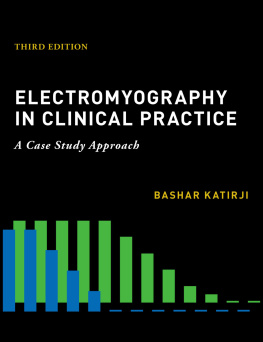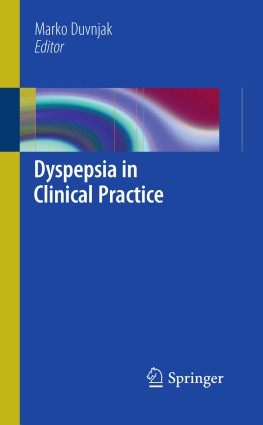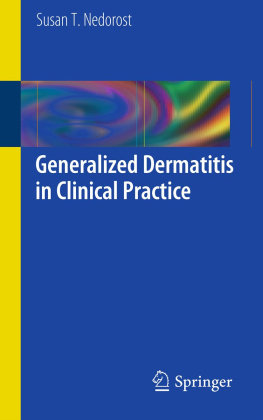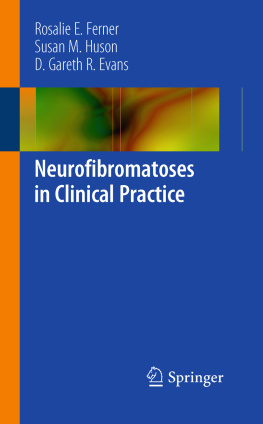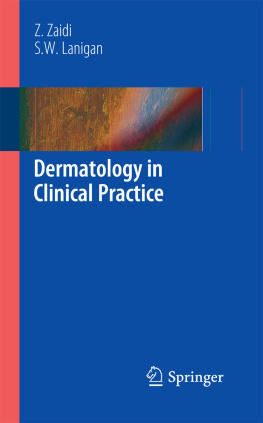Bashar Katirji MD FACP - Electromyography in Clinical Practice
Here you can read online Bashar Katirji MD FACP - Electromyography in Clinical Practice full text of the book (entire story) in english for free. Download pdf and epub, get meaning, cover and reviews about this ebook. year: 2018, publisher: OUP Premium, genre: Children. Description of the work, (preface) as well as reviews are available. Best literature library LitArk.com created for fans of good reading and offers a wide selection of genres:
Romance novel
Science fiction
Adventure
Detective
Science
History
Home and family
Prose
Art
Politics
Computer
Non-fiction
Religion
Business
Children
Humor
Choose a favorite category and find really read worthwhile books. Enjoy immersion in the world of imagination, feel the emotions of the characters or learn something new for yourself, make an fascinating discovery.
- Book:Electromyography in Clinical Practice
- Author:
- Publisher:OUP Premium
- Genre:
- Year:2018
- Rating:5 / 5
- Favourites:Add to favourites
- Your mark:
- 100
- 1
- 2
- 3
- 4
- 5
Electromyography in Clinical Practice: summary, description and annotation
We offer to read an annotation, description, summary or preface (depends on what the author of the book "Electromyography in Clinical Practice" wrote himself). If you haven't found the necessary information about the book — write in the comments, we will try to find it.
Electromyography in Clinical Practice — read online for free the complete book (whole text) full work
Below is the text of the book, divided by pages. System saving the place of the last page read, allows you to conveniently read the book "Electromyography in Clinical Practice" online for free, without having to search again every time where you left off. Put a bookmark, and you can go to the page where you finished reading at any time.
Font size:
Interval:
Bookmark:


Oxford University Press is a department of the University of Oxford. It furthers the Universitys objective of excellence in research, scholarship, and education by publishing worldwide. Oxford is a registered trade mark of Oxford University Press in the UK and certain other countries.
Published in the United States of America by Oxford University Press
198 Madison Avenue, New York, NY 10016, United States of America.
Oxford University Press 2018
All rights reserved. No part of this publication may be reproduced, stored in a retrieval system, or transmitted, in any form or by any means, without the prior permission in writing of Oxford University Press, or as expressly permitted by law, by license, or under terms agreed with the appropriate reproduction rights organization. Inquiries concerning reproduction outside the scope of the above should be sent to the Rights Department, Oxford University Press, at the address above.
You must not circulate this work in any other form and you must impose this same condition on any acquirer.
Library of Congress Cataloging-in-Publication Data
Names: Katirji, Bashar, author.
Title: Electromyography in clinical practice : a case study approach / Bashar Katirji.
Description: Third edition. | New York, NY : Oxford University Press, [2018] |
Includes bibliographical references and index.
Identifiers: LCCN 2018001467 | ISBN 9780190603434 (alk. paper) | ISBN 9780190603458 (epub)
Subjects: | MESH: Neuromuscular Diseasesdiagnosis | Electromyography | Case Reports
Classification: LCC RC77.5 | NLM WE 560 | DDC 616.7/407547dc23
LC record available at https://lccn.loc.gov/2018001467
This material is not intended to be, and should not be considered, a substitute for medical or other professional advice. Treatment for the conditions described in this material is highly dependent on the individual circumstances. And, while this material is designed to offer accurate information with respect to the subject matter covered and to be current as of the time it was written, research and knowledge about medical and health issues is constantly evolving and dose schedules for medications are being revised continually, with new side effects recognized and accounted for regularly. Readers must therefore always check the product information and clinical procedures with the most up-to-date published product information and data sheets provided by the manufacturers and the most recent codes of conduct and safety regulation. The publisher and the authors make no representations or warranties to readers, express or implied, as to the accuracy or completeness of this material. Without limiting the foregoing, the publisher and the authors make no representations or warranties as to the accuracy or efficacy of the drug dosages mentioned in the material. The authors and the publisher do not accept, and expressly disclaim, any responsibility for any liability, loss or risk that may be claimed or incurred as a consequence of the use and/or application of any of the contents of this material.
To my wife Patricia, my children Linda and Michael, and my parents Malak and Zakaria.
Without their love, encouragement, and blessing, this work could not have been achieved.
It has been more than 10 years since the second edition of Electromyography in Clinical Practice was published. During this interval, there have been significant advances in the field of neuromuscular medicine. New themes have emerged, new methods and technologies have been adopted, and old ideas have fallen by the wayside. Also, neuromuscular medicine completed the process of formally accrediting fellowship training programs by the Accreditation Council for Graduate Medical Education and developed, in 2008, its own subspecialty board under the auspices of the American Board of Medical Specialties.
With the third edition of this book, I have kept the essential backbone of the book the same as in previous editions. The main themes of the book remain to present and discuss real-life neuromuscular cases that I encountered in my clinical practice over the past 35 years. Part I contains foundational chapters that explain simply the concepts of electromyography that are core to the understanding of the discipline. This section was added to the second edition for the beginner who may not be familiar with the techniques, terminology, and basic concepts of clinical electromyography. Subsequent chapters then built upon those foundations. Part II contains cases with discussions that explore focal disorders affecting the lower and upper extremities. Part III discusses cases with generalized neuromuscular disorders.
The third edition is slightly longer than the second edition, published in 2007. The new chapters are more extensive and focus as much as possible on basic concepts and principles. All the old chapters and cases were overhauled, most of them significantly restructured, updated, and extended. There are many new sections within the updated chapters and cases. I have added and replaced many of the tables, diagrams, and figures and updated all the references. In this edition, I changed the organization of the case discussion and used a query format as a heading for each of the subtitles.
Educators who have previously taught from this book should find the revised third edition coherent and comprehensive. The text provides basic-science information that is critical to the understanding of pathophysiology but also focuses directly on crucial aspects of clinical practice. Areas of emphasis include applied anatomy and physiology, the approach to the patient, clinical features and differential diagnosis, and state-of-the-art electrodiagnostic findings.
To gain the most benefit, my suggestions on approaching the book are as follows: Each case should be read without knowledge of the diagnosis. The history and examination should be read first, followed by analysis of the data of the nerve conduction studies and needle EMG findings, both shown in tabular forms. The reader should then make his or her own final diagnosis/differential diagnosis and answer the questions that are intended to test his or her understanding of the case. Not all the answers to the questions are easy or obvious, and some are specifically designed to challenge. This will encourage the subsequent discussion of the disorder pertinent to each case. I wrote the interpretation of nerve conduction and needle EMG data in a very simple and practical manner, mimicking bedside daily discussions in the electromyography laboratory.
Electromyography in Clinical Practice is a single-author text designed to be used by trainees as well as medical practitioners, nurses, and allied health professionals involved in patient care. The text is presented in a way that should make it accessible to anyone, independent of prior knowledge in clinical electromyography. It is suitable as a primer for residency and fellowship training and as an introductory textbook for those pursuing a career in neuromuscular medicine. The book is helpful for students of clinical electromyography preparing to take a board examination or recertification including in the American Board of Psychiatry and Neurology, neuromuscular medicine, clinical neurophysiology, or electrodiagnostic medicine.
Bashar Katirji, MD, FACP
Cleveland, Ohio
I have been delighted with the enthusiastic reception given by physicians to the first edition of this book since its publication 10 years ago (1997). The aim of the book was to provide case-based learning of the most commonly encountered neuromuscular disorders in the EMG laboratory. The second edition maintains the main mission of reducing the gap between theory and practice in the field of electrodiagnostic medicine. In this edition, a new section (Part I) was added pertaining to the fundamentals of EMG. This section serves as an orientation and a quick guide to the readers who are not familiar with the techniques, terminology, and basic concepts. It is divided into four chapters: describes the findings in various neuromuscular diseases. Part II contains all the cases. Though most cases were unchanged from the first edition, a few new ones were added and many were enriched with new and improved waveforms, tables, and updated references. The discussions are longer in this edition and include new advances in the field, such as the increased use of comparison internal nerve conduction studies in the diagnosis of carpal tunnel syndrome, inching techniques in the diagnosis of ulnar nerve lesions, and quantitative motor unit analysis in the diagnosis of myopathy and neurogenic disorders.
Font size:
Interval:
Bookmark:
Similar books «Electromyography in Clinical Practice»
Look at similar books to Electromyography in Clinical Practice. We have selected literature similar in name and meaning in the hope of providing readers with more options to find new, interesting, not yet read works.
Discussion, reviews of the book Electromyography in Clinical Practice and just readers' own opinions. Leave your comments, write what you think about the work, its meaning or the main characters. Specify what exactly you liked and what you didn't like, and why you think so.

